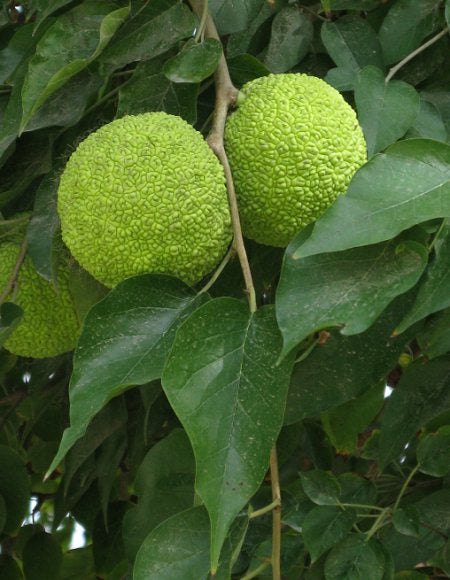Osage orange, Maclura pomifera
Shipping calculated at checkout
Out of stock
Need more? Contact us
The Osage Orange (Maclura pomifera; syn. Maclura aurantiaca) is like the mulberry, apparently its closest relative, a tree of the Moraceae family. This small tree rarely reaching more than 8 m in height is also known by the following synonyms: thorny maclusa and antler.
It is a dioecious species of thorny deciduous tree or shrub. Female trees produce green fruits the size of an orange or larger. In fact, it is not a simple fruit but like the fig or rather the breadfruit of an infructescence, that is to say, an agglomeration of a set of fruits resulting from 'a multitude of flowers. The inside of the fruit is white, compact, homogeneous with small dark brown seeds. The fruit exudes a slightly spicy lemony scent. The common name comes from the Osage Indian tribe, who occupied the area where this tree grows. It is native to North America and more specifically to southeastern Oklahoma, southwest Arkansas and northeastern Texas. It is also found in Missouri, near the Mississippi. It is never very abundant. In Quebec, you can observe some healthy specimens at the Montreal botanical garden. Its hardiness is limited to zone 5a at least but tests are underway in zone 4b. It is planted as an ornamental and collector's tree in temperate zones.
The fruit is inedible because of its bitterness. The Native Americans of the Osage tribe (related to the Sioux) used the milky latex contained in the fruit and other organs to paint their faces and dye their clothes. In fact, upon contact with air, latex turns yellow. The wood was also used in the past for the manufacture of their bows, hence the vernacular name of bois d'arc sometimes given to this tree. In Eastern Europe, traditional medicine uses it against rheumatism, for healing wounds or as an antibiotic, as well as to stimulate cardiac activity. In the wild, these fruits are practically not consumed by animals, apart from squirrels which search for the seeds. It is unusual for a large fleshy fruit not to be consumed by seed-dispersing animals. It has recently been hypothesized that its fruits were once consumed by the Megatherium, which became extinct shortly after the first human settlements on the New World. Horses, which existed in North America but were extinct before the arrival of Europeans, can eat them. source wikipedia



